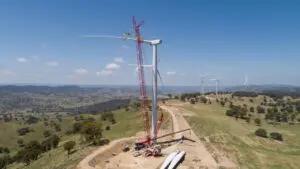It’s an obvious thing to observe, but the emissions benefit of renewable energy comes not from its own operation, but from the higher emissions electricity that it supplants.
Right now, policy makers have a live opportunity to draw on this ‘displacement effect’, making a small but significant adjustment that can help squeeze out more emissions from the renewable energy transition that’s underway.
The opportunity relates to the planned arrival of a new renewable electricity certificate to be known as a REGO (renewable electricity guarantee of origin), that will coexist with the current Large-scale Generation Certificates (LGCs) and then, beyond 2030, replace them.
With a key design feature built into the REGO certificate scheme, voluntary buyers can drive deeper decarbonisation.
Rooftop solar and large-scale wind and solar output have grown to the point where they contributed well over 30% of NEM energy over the past year. Continued growth will be essential for the decarbonisation we need to achieve as we head towards net zero. Part of this growth will come from electricity buyers – large and small – voluntarily purchasing renewable electricity certificates.
To power up the impact of the new voluntary market instrument we should ensure that each REGO from each renewable megawatt hour is stamped with a simple measure of the power system emissions it displaced. It’s an easier metric to attach than it might appear.
As things currently stand, before the introduction of the REGO, electricity users are able to buy an LGC (sometimes packaged as GreenPower) to balance each megawatt hour of electricity they draw from the grid.
In doing this, the understanding is that they can continue to draw from the grid when they need energy, powered by whatever generators are producing at that time, and that an equal amount of pure renewable energy will enter the system to balance that volume out.
Carbon neutral standards including Australia’s Climate Active make this neutrality assumption explicit.
But there is a critical false economy operating here – the megawatt hours exchanged are rarely equivalent in their emissionality. Except under perfect demand matching, 100% renewable certificate energy use is not 100% emissions free.
Different times of day, and different times in the year, tend to correspond to different levels of emissions intensity in the power system, subject to variation from weather and power station output.
Solar output through the middle of the day generally lowers average power system emissions while nights and winter wind droughts often see more heavy reliance on coal and gas power stations, with higher corresponding average emissions intensity.
Grid energy used at these times is therefore typically higher in emissions than the average reduction that is achieved from the purchase of the same volume of renewable electricity.
On balance, the renewable megawatt hour that displaced, say, 0.3 tonnes of CO2-e grid emissions in the middle of the day when solar output was abundant doesn’t offset the grid energy used, for example overnight, when system emissions for the same volume of energy might be more than 0.7 tonnes.
We can, and should, pursue better coverage of the true emissions involved.
The Australian Energy Market Operator produces a daily Carbon Dioxide Equivalent Intensity Index (CDEII) for the NEM. That index already contains data for each NEM State showing the tonnes of greenhouse gas emissions that can be displaced by each megawatt hour of renewable electricity.
The CDEII could presumably be expanded to provide dispatch interval emissions intensity data for each state so that energy users can readily calculate their energy use emissions.
With this same data stamped on each REGO for each megawatt hour of renewable and zero emissions energy storage output, buyers could see how much their purchases reduce emissions.
With this emissions information, the green certificate market could benefit from more efficient price discovery and strong liquidity, while driving more renewable-origin electricity into more hours of the day and the year.
The federal government is doing detailed design work to enable the REGO scheme to commence as early as 2024. It is considering the information attributes that could be contained on each REGO certificate, including time stamping and multiple other details.
Listing the time, location and other attributes of each unit of renewable electricity may go some way to helping discerning buyers to increase their impact and lower emissions, but these attributes are a lesser proxy for power system emissionality than an emissions stamp, inspired by the CDEII.
The use of multiple proxy data markers rather than emissions might also lead to splintering and price stratification, and ultimately less successful emissions reduction.
Thanks to Australia’s exceptional data infrastructure, we have an opportunity to jump straight to the heart of the matter.
If we understand the greenhouse gas reduction achieved for each megawatt hour of renewable-origin electricity, energy buyers can modify or expand their certificate purchases and investment can be stimulated where it’s needed. These small actions move the system closer to net zero emissions.
Small design features matter if they build to faster and more complete emissions reductions. The decarbonisation of the power system and energy use is critical to the broader decarbonisation of Australia’s economy. In this crucial decade for action, we don’t have time to leave any potential gains on the table.
Anna Hancock is an Executive Director at climate change investment and advisory firm Pollination. She is former Head of Sustainability and Climate at Energy Australia and is a Board member of the Carbon Markets Institute








